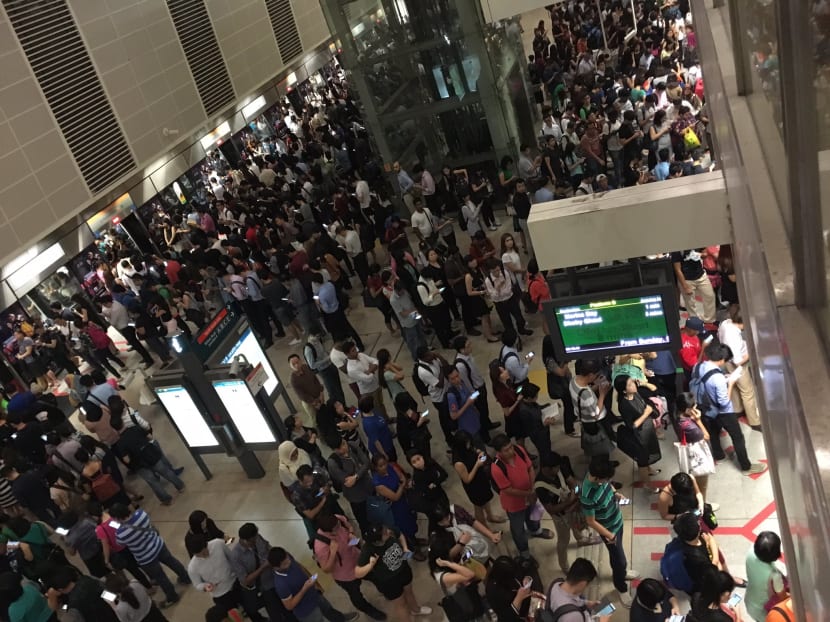Faulty hardware on single train identified as cause of CCL issues
SINGAPORE — After spending months investigating a mysterious signal interference causing Circle Line (CCL) disruptions — which saw mobile signals shut down on the entire line for a day, then military experts brought in — it turned out that the culprit was faulty signalling hardware on one SMRT train, Passenger Vehicle 46.
SINGAPORE — After spending months investigating a mysterious signal interference causing Circle Line (CCL) disruptions — which saw mobile signals shut down on the entire line for a day, then military experts brought in — it turned out that the culprit was faulty signalling hardware on one SMRT train, Passenger Vehicle 46.
The “rogue” train, as Transport Minister Khaw Boon Wan described it, caused trains in its proximity to lose signalling communications, triggering emergency braking, as a safety feature.
This happened on about 100 occasions on Nov 2 and Nov 6. There was also a “strong likelihood” that the same hardware failure was behind about 200 such occurrences between Aug 28 and Sept 2.
The Land Transport Authority (LTA) revealed these details on Friday (Nov 11), adding that the affected train, which was put into service in July last year, has been removed.
In a statement, LTA chief executive Chew Men Leong said: “The sporadic occurrence of the incidents at different points along the Circle Line made it challenging for the investigators.”
At a media briefing, the LTA said it cannot conclude if someone had sabotaged the signalling equipment on Passenger Vehicle 46, but noted that it was the first time they had encountered such a problem.
Further investigations will be carried out over the next few weeks to find out what caused the hardware in question to break down, while the rest of the CCL fleet will be checked, the LTA added.
CCL trains are owned by the LTA and maintained by SMRT. The hardware in question was designed, manufactured and tested in France by its manufacturer Alstom. Installation on the train was done in China.
“The LTA will require Alstom to make good any inherent defects, if these are found to have caused the faults,” said a spokesperson.
Interfering signals were first detected on the CCL in late August and persisted until earlier this month. To get to the bottom of the cause, various steps were taken by the authorities, including reverting to old signalling software, checking station equipment and putting in place portable scanners in trains to pick up anomalies. Mobile signals were also suspended on the line on three separate occasions, but the authorities found that CCL trains continued to lose communications during the blackout.
Finally, engineers and data scientists from the Defence Science and Technology and the Government Technology Agency of Singapore were roped in to investigate. Poring through the “large amounts of information” on system logs and applying data analytics, the authorities picked up a trend of Passenger Vehicle 46 being in the vicinity of almost all the signal faults.
Their finding was confirmed in a test during non-revenue hours last Sunday, where Passenger Vehicle 46 was put into service and nearby trains lost communication with the trackside signalling system.
Tests by electro-magnetic interference specialist Rohde & Schwarz showed that Passenger Vehicle 46 was emitting erroneous signals which affected trains in its vicinity — including the one on the parallel track travelling in the opposite direction.
The LTA said it will continue to explore the use of electromagnetic shields on trains as part of measures to minimise interfering signals.
In a Facebook post on Friday, Defence Minister Ng Eng Hen lauded the teams from DSTA and the DSO National Laboratories — which was also involved in the CCL investigation — for using their expertise to help catch the “culprit” of the mystery stray signals.
“That just one ‘rogue’ train could jam the entire system shows the importance of electronic warfare and I’m glad we have the experts to defend us,” he wrote.
Professor Lim Teng Joon of the National University of Singapore, who specialises in wreless communications, expressed surprise that the source of the fault was not narrowed down earlier, and instead, mobile signals had been seen as the “prime suspect”.
“If cellular interference was the cause then the fault would have occurred more frequently in the past since nothing significant changed in the cellular networks on the days of the breakdowns,” he noted.
But transport analyst Park Byung Joon said that since electromagnetic interference caused by mobile signals is the most common cause of intrusion, it is understandable for the authorities to focus on eliminating it as a cause.
Member of Parliament Ang Hin Kee (Ang Mo Kio GRC), who sits on the Government Parliamentary Committee for Transport, said ensuring train reliability will require the same multi-disciplinary approach seen in the investigations into the signal interference. He added that a similar approach could be useful at the procurement stage and maintenance of the rail networks.







